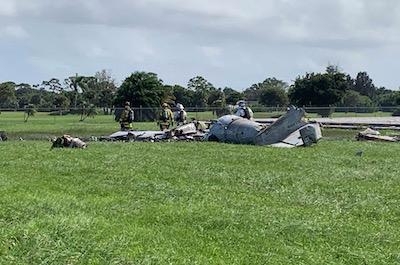Was Participating In An Air Show In Stuart, FL
The NTSB has released its preliminary report from an accident which occurred November 1 involving a Grumman OV-1D which was participating in the Audi Stuart Airshow. The Air Transport-rated pilot of the airplane was fatally injured when it went down near the approach end of runway 30 at Witham Field (KSUA) in Stuart, FL.

According to the report, the pilot was scheduled to perform a 12-minute routine that day. Personnel interviewed by NTSB reported differing number of passes performed after takeoff.
The person who was acting as crew-chief, and whom had accrued about 880 hours in the same make and model airplane during military conflict, reported that the pilot informed him and another individual before departure that no acrobatic maneuvers were to be performed due to the ceiling and wind conditions. The crew-chief stated that the pilot's, "…only reason to fly was to visually locate the acrobatic box so he would be ready [for] the show on Saturday. His intent was to make a slow speed low pass followed by a high speed low pass and a normal landing to a full stop." The crew-chief observed the pilot perform a check of all flight controls, flaps, and speed brakes while taxiing to takeoff adding all appeared to move and work normally. He reported that from his vantage point on the last pass when turning from base leg of the airport traffic pattern onto final leg of the airport traffic pattern, it appeared the bank angle exceeded 90°. The airplane then did a rapid right roll to an inverted
position, and the nose dropped to what appeared to be 45° nose down followed by impact and fireball. He added that he did not see the speed brakes deploy or the landing gear extend.
An airshow performer who was about 2,150 ft north-northwest of the accident site reported that after departure from runway 30, the airplane began to climb, followed by a "dog leg" to the left followed by a right turn to enter the aerobatic box. The airplane then descended or dove in, and when near the approach end of runway 30, began to climb. He then diverted his attention, and when he looked back, the airplane was near the approach end of runway 30, facing approximately down runway 34, "overbanked" about 100° to the right. He then saw the airplane in a nose low attitude pulling, which continued until he lost sight. He added that the engines sounded like they were at full power. He heard the impact and then saw smoke.
Another witness, who was also an operations inspector with the FAA, and who was standing near show center (about 3,770 ft northwest of the accident site) reported seeing the airplane flying inverted in a nose level attitude heading in a southeasterly direction. She looked to another inspector briefly, then observed the airplane in a 45° nose-down attitude "spiralling" to the right, providing a view of the upper part of the airplane. She did not see the impact, nor did she see any smoke trailing the airplane, or see components of the airplane separate. She thought the airplane was accelerating (consistent with power) or at least maintaining a constant rate during the descent, indicating to her that it was not decelerating.
A pilot-rated witness who was 15 ft above ground level on the Air Boss stand, which was located about 3,700 ft northwest of the accident site, reported hearing the pilot announce on the radio he would do a "low show"; the pilot sounded calm during that transmission. At that time the ceiling was ragged and moving to scattered at 1,600 ft. The pilot was setting up for his last pass and flew parallel to the runway 12 showline. The pilot then initiated a climb at the west end of the field achieving about 15° of pitch, which he held for a few seconds, then the pitch increased to 35°. At that time the witness saw blue sky behind the airplane. The blue sky remained, then while at 1,000 to 1,300 ft above ground level (agl), he noted a "crisp" right roll to 135° of bank which was stabilized. The airplane continued the brisk pull as it approached 180° of bank; the speed increased and the turn radius decreased. After completing 170° of heading change, while at 500 feet agl, the witness did
not notice any wing rock or longitudinal change. The engines sounded fine to him. He did not see any attempt to unload the wings. During the last 200 ft of descent, the rotation rate increased slightly.
Airport security video depicted the final portion of the flight. A review of the provided video revealed that immediately before impact, the airplane was in about a 60° nose low and right wing low attitude. The video depicted the bottom and left side views of the airplane. The landing gear and left speedbrake were retracted, and all three vertical stabilizers were visible. The positions of the left aileron, left elevator, and rudder flight control surfaces could not be accurately determined.
The airplane impacted onto the Engineered Materials Arresting System (EMAS) at the approach end of runway 30. The wreckage was recovered for further examination.
(Source: NTSB. Image from file)
 Airborne 04.16.24: RV Update, Affordable Flying Expo, Diamond Lil
Airborne 04.16.24: RV Update, Affordable Flying Expo, Diamond Lil ANN's Daily Aero-Term (04.20.24): Light Gun
ANN's Daily Aero-Term (04.20.24): Light Gun Aero-News: Quote of the Day (04.20.24)
Aero-News: Quote of the Day (04.20.24) Aero-News: Quote of the Day (04.21.24)
Aero-News: Quote of the Day (04.21.24) ANN's Daily Aero-Term (04.21.24): Aircraft Conflict
ANN's Daily Aero-Term (04.21.24): Aircraft Conflict



